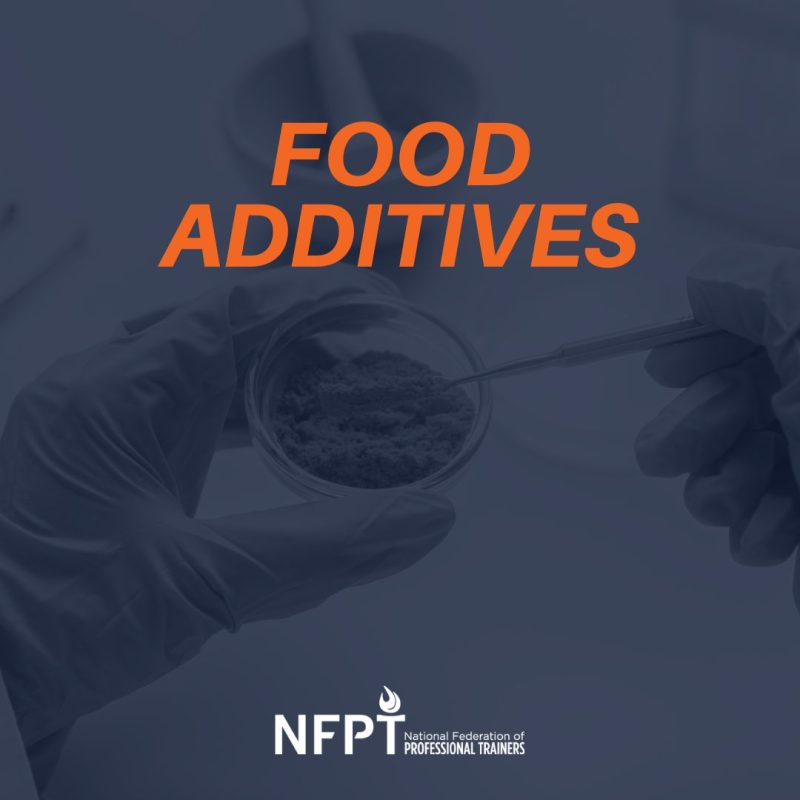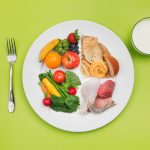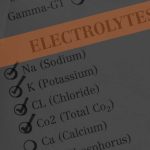
People are paying closer and closer attention to the labels of items they’re putting in and on their bodies now more than ever. How can we trust ingredient labels? How do we know what’s truly safe, what’s toxic, and what is okay based on serving size? How do we give our honest feedback to our personal training clients who are trying to make changes to their lives that, as it should, include recommendations about nutrition and consuming things like food additives?
Tasty, Ticking Timebombs?
Let’s start with companies that put additives, bio-engineered flavorings, and artificial dyes into our foods. It’s probably no mystery that foods that look and taste good sell better. It’s not only about what initially tastes good, but sneaking sugar into just about everything is a tactic marketing strategists know will activate pleasure centers in the brain. It’s not a far leap to figure that this will “hook” the consumer on their product.
We see this frequently in some of the pre-workout and energy supplements clients use or come to us asking, “Is this healthy?”
While children might be swooning over a certain sugar-filled cereal, you could be seeking out labels like “no artificial flavors or colors” or “gluten and dairy-free!” or a new fan favorite “plant-based!” as seen on Reese’s newest oat milk-based chocolate treats.
Is one really better than the other when we break down ingredient lists against their marketing claims? Let’s dive a little deeper.
Manufactured Consistency
Items with plant-based claims especially tend to boast natural ingredients. But, often in an attempt to minimize or eliminate dairy or animal-based products, they add in far more lab-engineered ingredients to achieve an identical taste and (often creamy) consistency that folks who consume traditional dairy or animal-based products are accustomed to.
Ingredients such as guar/acacia/locust bean gum, sunflower lecithin, carrageenan, xylitol, dextrose, and maltodextrin are used to create a desired consistency, flavor, and extend the shelf life of their dairy-based counterparts. These items can cause gut bacteria disruption and lead to high levels of inflammation in GI tract lining.
One may not notice much more than a few unhappy grumbles of the stomach if only periodically consuming these foods. However consumption of these ingredients consistently over time–like in the case of an individual that is electing to adhere to a vegetarian or vegan diet–could lead to exacerbated symptoms such as bloating, cramps, diarrhea, and even skin issues as the body tries to expel items that it can’t properly digest and absorb.
Seed Oils
Seed oils are another topic that’s recently climbed high on the agenda for health professionals. The trouble with seed oils is that they are in quite literally almost every pre-packaged and, especially heavily processed, food items. You’ll likely find some form of sunflower, safflower, vegetable, canola oil combination on the back of just about any item you grab off the shelf in the grocery store.
These oils are refined, stripped, bleached, and dyed with chemicals to become the flavorless-colorless oils combined in these food products. Why would these companies go through all the trouble to create something so ultra-processed when the result is essentially, tasteless, flavorless, colorless, and odorless?
Hydrogenated and Partially Hydrogenated Oils are trans fats that have the same cholesterol-raising effect that saturated fats do. Hydrogenation is a synthetic process that involves heating an oil and passing hydrogen bubbles through it. Fatty acids in the oil pick up the hydrogen. The more hydrogen is picked up, the more dense the oil becomes. Fully hydrogenated oils are solid at room temperature; partially hydrogenated oils are less solid, like margarine and shortening. Cheaper than butter, but containing a rich texture and consistency, partially hydrogenated oils are used as a substitute for butter by thousands of food manufacturers.
However, research is proving that the dangers of hydrogenated and partially hydrogenated oils far outweigh any possible benefits for consumption. Not only have they been proven to increase LDL (poor) cholesterol, they can also decrease HDL (good) cholesterol. Studies have even shown that the negative effect on blood cholesterol levels when consuming trans fats is twice that of consuming similar amounts of saturated fat.”
What’s even crazier is that these ultra-processed and highly inflammatory oils are in products you wouldn’t suspect, like your daily coffee creamer. When it comes to most things, the poison is in the dose. However, when the dose is in just about every item the majority of Americans consume daily, it’s no wonder so many health professionals are concerned.
Certain oils such as High Oleic Safflower and Linoleic Sunflower Oil are often touted as “heart-healthy” because they are higher in monounsaturated fats than polyunsaturated like Omega fats–the former of which has been associated with reduced risk for heart disease. However, when you break this down further, the issue boils down to the ratio of Omega-6 to Omega-3 fatty acids. On their own, Omega-6 fats–which are predominant in these two oils–are not damaging, but when consumed in a higher ratio than Omega-3’s, this can have negative health effects.
IBS and ulcerative colitis cases have skyrocketed over the last 30 years, with a major culprit being the Standard American Diet and the overwhelming frequency of said artificial flavors, colors, and bio-engineered ingredients. Accordingly to the CDC, “Inflammatory bowel disease (IBD), including Crohn’s disease and ulcerative colitis, is characterized by chronic inflammation of the gastrointestinal tract. The number of affected persons worldwide has increased from 3.7 million in 1990 to 6.8 million since
2017.” And those numbers are climbing.
The FDA allows a claim of ‘0 grams of Trans Fat’ to appear on food labels as long as the amount of trans fat is below .5 grams per serving. When in doubt, it’s best to read the label and determine what you’re really consuming. In addition, it’s important to keep the total amount of fat consumed to 30% or less of the daily caloric intake, with 10% or less coming from saturated fat and/or trans fats.
Protein Bioavability Enhancers
Hydrolyzed Vegetable Protein (HVP) or Hydrolyzed Plant Protein (HPP) is added to foods to make protein more bioavailable. Hydrolyzed protein is often used in protein supplements, as emulation stabilizers and foaming aids in a variety of personal care products.
The hydrolyzation process breaks protein down into individual amino acids, which are then quickly absorbed by the body once ingested, a plus for bodybuilders and athletes. However, in this case, there is a small catch. During digestion, the chemical reaction that occurs in the body when breaking down HPP and HVP sometimes results in the formulation of glutamate. This glutamate may join with free sodium to form MSG.
Ingredients Used in Food Flavoring
Flavor-enhancing ingredients are added to foods to intensify or bring out more of a food’s natural flavors. Monosodium Glutamate (MSG), autolyzed yeast extracts, and maltodextrin are three of the most common artificial additives on the market.
Monosodium Glutamate (MSG) is a flavor enhancer best known for its use in fast food, but also widely used in other types of food. MSG is generally recognized as safe, but many people do not metabolize this additive well. This causes a buildup of MSG in the bloodstream and is responsible for what’s known as ‘Chinese Restaurant Syndrome’.
Symptoms of this syndrome include burning or tingling of the face and chest, perspiration, excessive abdominal cramping, dizziness, and headaches. People who have problems with MSG should avoid foods containing the additive as well as foods with hydrolyzed vegetable protein (HVP) and hydrolyzed plant protein (HPP) for reasons to be discussed shortly.
Autolyzed Yeast Extracts are created via autolyzation process–the partial breakdown of yeast cells by their own enzymes to create a partially non-soluble flavor enhancer. It is often used in meats and baked goods to produce a roasted, toasted, or grilled flavor. There are no known side effects to eating autolyzed yeast extracts, but if a person is allergic to yeast, it’s best to avoid foods containing these extracts. Unfortunately for MSG-sensitive people, foods with HVP and HPP do not need to list MSG as an ingredient because the MSG is created once the food is ingested.
Maltodextrin is a flavoring agent made from natural cornstarch in a process known as partial hydrolysis that breaks the starch into smaller polymers. As a safeguard for people with food allergies and sensitivities, the FDA requires all maltodextrin in the U.S. to be produced using only corn or potato.
Maltodextrin is used in a wide variety of products to increase the shelf life of sweets, prevent granulation, give foods a powdery appearance, act as a ‘filler’ ingredient, prevent melting, lower sweetness, change taste of a food, and in beverages to enhance the natural smell and reduce nutrient loss. It is also used in cosmetics to enhance skin luster and elasticity. However, due to maltodextrin’s extremely high glycemic index, diabetics and hypoglycemic individuals should monitor their consumption.
Natural Sweeteners
Natural sweeteners include date syrup, honey, agave, maple syrup, cane sugar, monk fruit sweeteners, coconut palm sugar, and even allulose. While considered natural, it is important to note that even those from plant-based sources can wreak havoc on metabolism and cause unwanted weight gain when portion sizes are not followed. Sugar, natural or not, still produces both an insulin response and a dopamine response which if not kept in check and in moderation can have catastrophic effects on gut and brain function, as well as overall health. Many trainers prefer to tell their clients to look for foods with under 10 grams of added sugar of any kind to keep the focus on whole food ingredients.
Sorbitol is a natural sugar found in peaches, pears, apple juice, plums, and prunes. It is also added to dietetic jam, sugarless gum, and chocolate. The body poorly metabolizes sorbitol and if a person eats an overabundance of food with sorbitol, they may experience gas, bloating, and diarrhea. Interestingly enough, some doctors are finding that infants who drink fruit juices high in sorbitol tend to suffer from constant stomach aches and diarrhea. Reduce the amount of juice and, in most cases, the problem goes away.
Fructose is the natural sugar found in fruits and vegetables. It can also be added to foods as a sweetener.
Sucrose is table sugar.
Artificial Sweeteners
Artificial sweeteners are those that do not occur naturally from whole food sources or are heavily processed from natural sugar sources to create a sweetening product. They include:
- Aspartame.
- Sucralose.
- Acesulfame K.
- Saccharin.
- Xylitol
- Corn syrup
- High Fructose Corn Syrup
Corn syrup or corn sweetener is formed when corn is treated with certain enzymes (hydrolyzed) to produce a synthetic honey. When fructose is added to the hydrolyzed corn syrup, the end product is high fructose corn syrup.
Aspartame is an artificial sweetener. It is 180 times sweeter than cane or white sugar. It can be found in a wide variety of foods and beverages such as diet sodas. Unfortunately, aspartame is not safe for everyone to consume. Studies have identified it as a major trigger for migraines and a cause of dizziness, shakiness, and diminished vision in certain individuals.
Aspartame and some of the other artificial sweeteners have a sort of Houdini effect on the body. The body prepares for digestion as it would with whole foods, but these artificial sweeteners essentially have 0 nutrient density for the body to pull from and absorb to turn to energy; they pull a disappearing act.
This tricks the body into desiring more items that contain these ingredients because there is nothing to signal fullness or satiety. It can throw off hunger hormones immensely. Even some of the “healthiest” branded items on the market can be deceiving both chemically by the body attempts to absorb and digest them, as well as how they are being marketed to us as mentioned above.
Saccharin is one of the more controversial sweeteners of our time. Used in Sweet’n Low, saccharin is a sugar substitute 300 times sweeter than sugar. For many years, it was widely believed that saccharin could cause bladder cancer, but those findings were later refuted. In May 2000, the FDA took saccharin off of the list of potential cancer-causing agents.
Aspartame is an artificial sweetener 180 times sweeter than sugar and is recognized as safe by the FDA. Found in Equal and Nutrasweet, it is used in a wide variety of foods and beverages such as diet sodas. Unfortunately, aspartame is not safe for everyone.
Research shows that it is a known trigger for migraine headaches and may cause dizziness, shakiness, and diminished vision in susceptible people. There is a rare hereditary disease known as phenylketonuria that affects approximately 15,000 people in the United States. Since aspartame contains phenylalanine, an amino acid that phenylketonurics don’t have the proper enzyme to break down, abnormally high levels of the amino acid will accumulate in the body. If left untreated, PKU can lead to severe brain and neurological damage.
Sucralose, (Splenda) is a derivative of sugar that’s 300 to 1,000 times sweeter than sugar, yet extremely low in calories. To produce sucralose, chlorine is added to normal sugar to change sugar’s chemical structure. Although approved by the FDA, no long-term studies have been done on this relatively new sugar substitute. The few studies that have been done on sucralose show that it may not be the safest thing to ingest.
Acesulfame-K (potassium) (Sunett) is a high-intensity sweetener, 200 times sweeter than sugar, that’s often used in baked goods because it doesn’t break down when heated. Similar in structure to saccharin, it is also used in more than 4,000 foods worldwide. Since it is safe for all populations and its calorie contribution is negligible, acesulfame-K is a good sugar substitution.
Neotame is a sugar substitute 8,000 times sweeter than sugar. Similar in structure to aspartame, it does not pose a risk for people suffering from PKU. Neotame can be used in cooking, baking and as a table sweetener. Approved by the FDA in 2002, many food and beverage manufacturers are working to incorporate neotame in their foods.
Sugar Alcohols
Malitol, sugar alcohol, is a low-calorie sugar substitute derived from malt extract and is used as a low-calorie sweetener to sweeten no-sugar products. Lower in calories than regular sugar, about 2.6 calories per gram compared to 4 calories per gram, sugar alcohols are technically not considered sugar or alcohol. Other sugar alcohols include: sorbitol, xylitol, lactitol, Hydrogenated Starch Hydrolysates (HSH), erythritol, and mannitol.
One word of caution, sugar alcohols have been known to cause bloating, gas, and diarrhea in some people, especially when consumed in large amounts.
Food Coloring Additives
There are natural food dyes that are derived from food products and there are synthetic, chemically-derived colors with names that sound so: Yellow no. 5 and Red no. 40 are two that make headlines for their effects on behavior and health.
The concerns revolve around the synthetic variety. Despite the FDA’s approval of many food dyes for consumption, new research is emerging about the impact of such substances on children’s health and behavior specifically.
As health and fitness professionals, we recommend keeping a diet closest to nature as possible, and synthetic dyes simply don’t fit into that picture. While the occasional indulgence or accidental ingestion won’t cause long-term harm, we should guide our clients to minimizing foods with synthetic dyes, most commonly candies and soft drinks.
Note: If an ingredient is stated as “artificial color” it does not imply that it is a synthetic color, only that it wasn’t naturally occurring in the product. Look for the chemical names.
Keeping The Client at the Center
While providing quality research in your guidance to your clients and anyone seeking a healthier lifestyle, it is important to always keep a client-centered approach with their goals in mind. Avoiding these items altogether might not be their goal now, but you can help them become aware of the current research, encourage them to seek and follow new studies, and make small changes at a time to lend to overall healthier living when they’re choosing foods to fuel their health and fitness journey at all stages.
References
1. Ascherio, Alberto, Stampfer, Meir J, Willett, Walter C. Departments of Nutrition and Epidemiology, Harvard School of Public Health; The Channing Laboratory, Department of Medicine, Brigham and Women’s Hospital, Trans Fatty Acids and Coronary Heart Disease. Copyright, 1999, President and Fellows of Harvard College. Access Date: 1-21-04.
2. Berglund, Duane R, Riveland, Neil, Bergman, Jerald. Safflower Production, . Access Date: 12-20-03.
3. Carper, Jean. Food: Your Miracle Medicine – Preventing and Curing Common Health Problems the Natural Way, Harper Paperbacks – HarperCollins. Copyright 1993 Jean Carper.
4. Chocolate Source Glossary. http://www.chocolatesource.com/ Access Date: 12-14-03.
5. Frequently Asked Questions: Natural Flavorings on Meat and Poultry Labels, Food Safety and Inspection Service, United States Department of Agriculture.
6. Kaplan, Phil. The Truth About Artificial Sweeteners. Copyright 1996-2004 ediets.com. Access Date: 12-10-03.
7. Lichtenstein, Alice H, Jauhiainen, Matti, McGladdery, Sandra, Ausman, Lynne M, Jalbert, Susan, Vilella-Bach Montserrat, Ehnholm, Christian, Frohlich, Jerry, Schaefer, Ernest J, Impact of Hydrogenated Fat on High-Density Lipoprotein Subfractions and Metabolism. TekTran, USDA, Agricultural Research Service, 2-12-02. Access Date: 12-15-03.
8. Margen, Sheldon, M.D., Ogar, Dale A. The Not-So-Sweet Side Effects of Artificial Sweetners, ThirdAge Health, Copyright 2002 Sheldon Margen and Dale Ogar.






